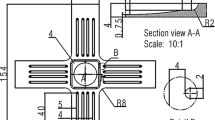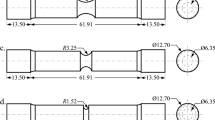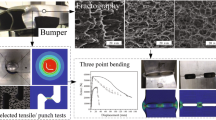Abstract
In this paper, the modified Mohr-Coulomb (MMC) ductile fracture criterion was adopted to analyze the fracture behavior of the AA6061-T6 aluminum alloy sheet during the U-bending process. Appropriate calibration procedures were employed using various tension tests. A finite element (FE) model was built using the commercial FE code Abaqus/Explicit incorporating the calibrated MMC fracture criterion. It was found that the MMC criterion calibrated by the uniaxial, plane strain, notched, and modified in-plane shear tension tests can predict the onset of fracture in the U-bending process with reasonable accuracy. The error of the predicted fracture displacement was about 2% as compared to experiments. Due to the dependency of the fracture prediction accuracy on the stress state, the effects of process parameters on stress triaxiality and normalized Lode angle parameter were investigated. The negligible effect of process parameters on the stress state confirmed that the calibrated fracture criterion (MMC) was able to predict fracture in different forming conditions with equal accuracy. Also, the proportional stress and strain state in the U-bending process indicate that, besides the high fracture prediction accuracy of the MMC’s damage accumulation function, the fracture forming limit diagram (under proportional loading assumption) can serve as a reliable tool for estimating the onset of fracture in the U-bending process. Therefore, a series of studies were also conducted on damage evolution, crack propagation, principal strains, and fracture displacement during the U-bending process under various forming conditions.




























Similar content being viewed by others
References
Stoughton BT, Yoon JW (2011) A new approach for failure criterion for sheet metals. Int J Plast 27:440–459
Wang H, Yan Y, Han F, Wan M (2017) Experimental and theoretical investigations of the forming limit of 5754O aluminum alloy sheet under different combined loading paths. Int J Mech Sci 133:147–166
Kotkunde N, Krishna G, Shenoy SK, Gupta AK, Singh SK (2015) Experimental and theoretical investigation of forming limit diagram for Ti-6Al-4 V alloy at warm condition. Int J Mater Form 10:255–266
Hashemi R, Madoliat R, Afshar A (2016) Prediction of forming limit diagrams using the modified M-K method in hydroforming of aluminum tubes. Int J Mater Form 9:297–303
Abed-Meraim F, Balan T, Altmeyer G (2014) Investigation and comparative analysis of plastic instability criteria: application to forming limit diagrams. Int J Adv Manuf Technol 71:1247–1262
Fatemi A, Mollaei Dariani B (2015) Forming limit prediction of anisotropic material subjected to normal and through thickness shear stresses using a modified M–K model. Int J Adv Manuf Technol 80:1497–1509
Mackenzie AC, Hancock JW, Brown DK (1977) On the influence of state of stress on ductile failure initiation in high strength steels. Eng Fract Mech 9:167–168
Khan AS, Liu H (2012) A new approach for ductile fracture prediction on Al2024- T351 alloy. Int J Plast 35:1–12
Bao Y, Wierzbicki T (2004) On fracture locus in the equivalent strain and stress triaxiality space. Int J Mech Sci 46:81–98
Wierzbicki T, Bao Y, Bai Y (2005) A new experimental technique for constructing a fracture envelope of metals under multi-axial loading. Proceedings of the 2005 SEM annual conference and exposition on experimental and applied mechanics. https://doi.org/10.1007/s11340-007-9053-9.
Johnson GR, Cook WH (1985) Fracture characteristics of three metals subjected to various strains, strain rates, temperatures and pressures. Eng Fract Mech 21:31–48
Rice JR, Tracey DM (1969) On the ductile enlargement of voids in triaxial stress fields. J Mech Phys Solids 17:201–217
Oyane M, Sato T, Okimoto K, Shima S (1980) Criteria for ductile fracture and their applications. J Mech Work Technol 4:65–81
Ayada M, Higashino T, Mori K (1987) Central bursting in extrusion of inhomogeneous materials. Adv Technol Plast 1:553–558
Bai Y, Wierzbicki T (2010) Application of extended Mohr–Coulomb criterion to ductile fracture. Int J Fract 161:1–20
Mohr D, Marcadet S (2015) Micromechanically-motivated phenomenological Hosford-Coulomb model for predicting ductile fracture initiation at low stress triaxialites. Int J Solids Struct 67:40–55
Lou Y, Huh H (2013) Prediction of ductile fracture for advanced high strength steel with a new criterion: Experiments and simulation. J Mater Process Technol 213:1284–1302
Mirnia MJ, Shamsari M (2017) Numerical prediction of failure in single point incremental forming using a phenomenological ductile fracture criterion. J Mater Process Technol 244:17–43
Mirnia MJ, Vahdani M, Shamsari M (2018) Ductile damage and deformation mechanics in multistage single point incremental forming. Int J Mech Sci 136:396–412
Hashemi SJ, Moslemi Naeini H, Liaghat GH, Azizi Tafti R (2015) Prediction of bulge height in warm hydroforming of aluminum tubes using ductile fracture criteria. Arch Civ Mech Eng 15:19–29
Zhan M, Gu C, Jiang Z, Hu L, Yang H (2009) Application of ductile fracture criteria in spin-forming and tube-bending processes. Comput Mater Sci 47:353–365
Azodi HD, Moslemi Naeini H, Parsa MH, Liaghat GH (2008) Analysis of rupture instability in the hydromechanical deep drawing of cylindrical cups. Int J Adv Manuf Technol 39:734–743
Hongsheng L, Yuying Y, Zhongqi Y, Zhenzhong S, Yongzhi W (2009) The application of a ductile fracture criterion to the prediction of the forming limit of sheet metals. J Mater Process Technol 209:5443–5447
Wang H, Yan Y, Jia F, Han F (2016) Investigations of fracture on DP980 steel sheet in roll forming process. J Manuf Process 22:177–184
Ko YK, Lee JS, Huh H, Kim H, Park SH (2007) Prediction of fracture in hub-hole expanding process using a new ductile fracture criterion. J Mater Process Technol 187:358–362
Luo M, Wierzbicki T (2010) Numerical failure analysis of a stretch-bending test on dual-phase steel sheets using a phenomenological fracture model. Int J Solids Struct 47:3084–3102
Thuillier S, Maout NL, Manach PY (2011) Influence of ductile damage on the bending behaviour of aluminium alloy thin sheets. Mater Des 32:2049–2057
Tsoupis I, Hildering S, Merklein M (2013) Prediction of damage in small curvature bending processes of high strength steels using continuum damage mechanics model in 3D simulation. Prod Eng Res Dev 7:239–249
Mishra A, Thuillier S (2014) Investigation of the rupture in tension and bending of DP980 steel sheet. Int J Mech Sci 84:171–181
Pradeaua A, Thuilliera S, Yoonb JW (2016) Prediction of failure in bending of an aluminium sheet alloy. Int J Mech Sci 119:23–35
Asadian-Ardakani MH, Morovvati MR, Mirnia MJ, Mollaei Dariani B (2017) Theoretical and experimental investigation of deep drawing of tailor-welded IF steel blanks with non-uniform blank holder forces. Proc IMechE B J Eng Manuf 231:286–300
Funding
This work was supported by the Iran National Science Foundation (Project No. 96004204) and the Russian Foundation for Basic Research (Project No. 17-58-560005).
Author information
Authors and Affiliations
Corresponding author
Additional information
Publisher’s note
Springer Nature remains neutral with regard to jurisdictional claims in published maps and institutional affiliations.
Rights and permissions
About this article
Cite this article
Talebi-Ghadikolaee, H., Moslemi Naeini, H., Mirnia, M.J. et al. Experimental and numerical investigation of failure during bending of AA6061 aluminum alloy sheet using the modified Mohr-Coulomb fracture criterion. Int J Adv Manuf Technol 105, 5217–5237 (2019). https://doi.org/10.1007/s00170-019-04549-6
Received:
Accepted:
Published:
Issue Date:
DOI: https://doi.org/10.1007/s00170-019-04549-6




